Fruits, Flowers, and Seeds
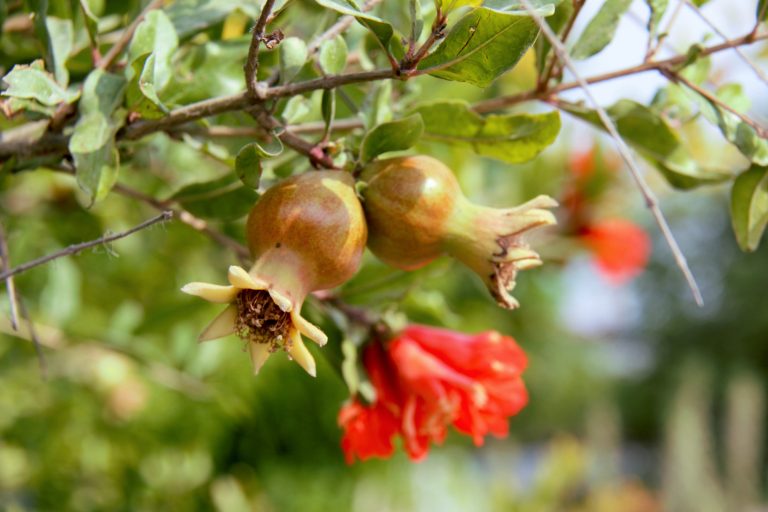
Flowers and tiny fruits of the pomegranate plant
Table of Contents
Flowering plants grow in a wide variety of habitats and environments. They can go from germination of a seed to a mature plant producing new seeds in as little as a month or as long as 150 years. Plants that complete their life cycle in a single season are called annuals while biennials take two years, and perennials may take several to many years to go from germinated seed to producing new seeds. There are two major classes of flowering plants, monocots and dicots— which have been mentioned previously in the Leaves and Stems tutorials. In order to keep these two classes separate in our minds, let’s take a moment and outline some of the differences between them.
Differences Between Monocots and Dicots
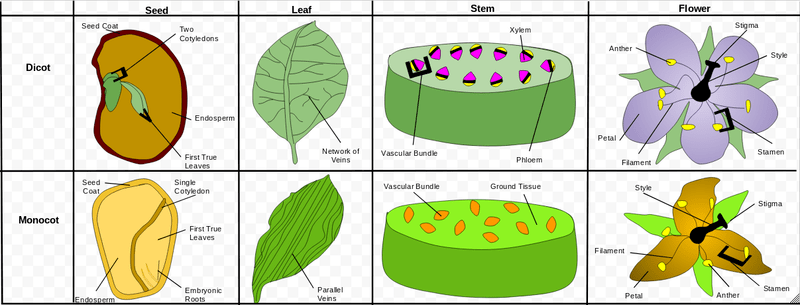
Monocots:
- One seed leaf—cotyledon
- Flower components in threes or multiples of three
- Leaf veins are parallel
- No vascular or cork cambiums
- Vascular bundles are scattered throughout the stem
- One aperture (thin spot) in pollen grains
Dicots:
- Two seed leaves—cotyledon
- Flower components in fours or fives or multiples of fours or fives
- Leaf veins are branching and networked
- Vascular cambium present, usually cork cambium present
- Vascular bundles are arranged in a ring in the stem
- Three apertures in pollen grains
Dicots account for slightly under three-quarters of all flowering plants. Nearly all flowering trees and shrubs are dicots as well as many annual plants. Monocots include bulb producing plants, grasses, orchids, and palms. They are primarily herbaceous, meaning no secondary woody growth.
Flowers
There are all sorts of flower shapes, sizes, colors, and arrangements; however, there are a few features that are central to all flowers regardless of their form. A flower starts as an embryonic primordium that develops into a bud and it is situated on a specialized branch at the end of a stalk called the peduncle. The receptacle is a small pad-like swollen area on the very top of the peduncle. This serves as the platform for the flower parts. Whorls, which are three or more plant parts, are attached to the receptacle. The sepals are the outermost whorl and are usually green. Sometimes they are confused with leaves. They are usually three to five in number and are collectively referred to as the calyx. The second whorl of flower parts are the petals and are collectively referred to as the corolla. The corolla is usually extra-showy in order to attract pollinators. In wind-pollinated plants, the corolla may be missing to maximize pollen exposure to the female flower parts. Just as the sepals in the calyx, the petals in the corolla may be fused together or occur as separate individual units. Nestled inside the two outer whorls are the sexual organs of the flower. The stamens entail the male structures: a semi-rigid filament with a sac called the anther dangling from the tip. Pollen grains develop in the anthers. Most anthers have slits or pores on the sides to accommodate pollen release. The female organs are collectively referred to as the pistil and include a ‘landing pad’ at the top called the stigma, a slender stalk-like style that leads down to the swollen base called the ovary. The ovary is what will develop/ripen into a fruit.
As you might have guessed, there are names for the different ways that the flower parts are arranged with respect to the ovary. The ovary is said to be superior if the calyx and corolla are attached to the receptacle at the base of the ovary. However, if the receptacle grows up and around the ovary and the calyx and corolla are attached above it, then the ovary is said to be inferior.
Inside the ovary is an egg-shaped ovule that is held in place within the ovary by means of a short stalk. The ovule is what develops into a seed. Fruits have seeds.
Some flowers are produced singly whereas others are produced in clusters called inflorescences. An inflorescence is characterized by one peduncle with many little stalks serving individual flowers. The little stalks, in this case, are called pedicels, and each stalk services one flower.
Fruits
The fruit is a mature or ripened ovary that usually contains seeds. In contrast, a vegetable can consist of leaves (lettuce, cabbage), leaf petioles (celery), specialized leaves (onions), stems (white potato), stems and roots (beets), flowers and their peduncles (broccoli), flower buds (globe artichokes) and or other parts of the plant. The fruit is by definition just the ovary part of a flower, therefore all fruits come exclusively from flowering plants.
Fruit regions
A fruit, ripened ovary, has three major regions that are sometimes difficult to distinguish from each other. The outer layer, sometimes referred to as the skin, is actually called the exocarp. The mesocarp is the fleshy portion that is usually eaten when consuming fruit. The endocarp is the innermost boundary around the seed. Sometimes the endocarp is hard and stony such as a peach pit that surrounds the seed. The endocarp can also be papery as in apples, where it is barely visible in cross-section. All three of these regions; the exocarp, mesocarp, and endocarp, are collectively called the pericarp. The pericarp can be quite thin, as is the case with dry fruits.
Some fruits have flower parts modified or fused to the ovary at maturity. Fruits are classified according to features at maturity: fleshy, dry, split exposing seeds, non-splitting, one ovary or multiple ovaries. We will go through these various classifications and see what examples fall into the various categories.
Kinds of fruits
Fruits may be classified based on the arrangement from which they derive: (1) simple fruits, (2) aggregate fruits, (3) multiple fruits, and (4) accessory fruits.
Simple fruits
Simple fruits are fruits that develop from a single or compound ovary with only one pistil (of a single flower). Simple fruits may either be fleshy or dry.
Fleshy Fruits
Fleshy fruits have a mesocarp that is at least partially fleshy at maturity. The ovary may be simple, meaning derived from one modified leaf called a carpel, or compound. The ovary also may be superior or inferior and may develop into a fruit with or without other flower parts integrated.
- Drupe— Drupes are simple fleshy fruits with one seed encased in a stony pit. Usually, the ovary is a superior ovary with one ovule. The stone fruits—cherries, peaches, olives, apricots, and almonds—are examples. Although not readily recognized as a fleshy fruit, coconuts are drupes. The husk is the mesocarp and exocarp which is generally removed before making it to the market. The pit with the watery seed endosperm is what we see piled up at the store.
- Berry—These develop from a compound ovary and usually contain multiple seeds. It is difficult to determine the three regions. This group is broken down further into three types of berries:
True berries are fruits with a thin skin and a pericarp. They are generally soft at maturity and usually have multiple seeds although dates and avocados are notable exceptions. Some berries have incorporated flower parts which can be seen in remnant as scars. Examples are tomatoes, grapes, peppers, blueberries, cranberries, bananas, and eggplants. Note that botanically speaking raspberries, strawberries and blackberries are not berries. Pepos are berry fruits with thick rinds. They have multiple seeds and include pumpkins, watermelons, cantaloupes, and squashes. Finally, the hesperidium is a leathery skinned berry that contains oils. Saclike outgrowths of the inner ovary wall become filled with juice as the ovary matures. All members of the Citrus Family produce hesperidium fruits. - Pome—The majority of the flesh in pomes comes from the swollen receptacle that grows up and around the ovary (inferior ovary). The seeds are encased by a leathery or papery endocarp. Apples are good examples. The apple core is the ovary with seeds and the rest is an overgrowth of the receptacle. (Sometimes these fruits that are derived from more than the ovary are called accessory fruits.) Examples of pomes include apples, pears, and quinces.
Dry fruits
Dry fruits have a mesocarp that is dry at maturity. Dry fruits that split at maturity distinguished by the way in which they split:
- Follicle—Splits along one side or one seam. Ex: larkspur, milkweed
- Legume—Splits along two sides or seams. Ex: Peas, beans, kudzu, peanuts, carob
- Silique—split along two sides or seams, the difference from legumes is that the seeds are carried on a central partition which is exposed upon splitting. Ex: Mustard Family, including broccoli, cabbage, radish, watercress
- Capsule—Most common of splitting dry fruit. Composed of two carpels and split in a variety of ways: along carpel partitions, through carpel cavities, pores, or via a cap that pops off to release seeds. Ex: irises, poppies, orchids, violets, and snapdragons.
Dry fruits that do not split at maturity: the single seed is more or less united with the pericarp.
Other kinds of dry fruits are as follows:
- Achene—the seed is attached to the pericarp (husk in this case) only at the bottom and can be separated easily. Ex: sunflower seeds (husk, plus edible seed constitutes the achene), buttercup, and buckwheat.
- Nut—the pericarp of nuts are generally harder than the achenes, although they are otherwise quite similar in structure. Nuts develop with a cup or cluster or bracts at their base. Ex: hazelnuts, hickory nuts, and chestnuts. Note that botanically speaking most things called ‘nuts’ are not nuts such as peanuts (legume), coconuts, almonds, walnuts, pecans (all drupes) Brazil nuts (capsule) and pistachios (drupes). Yet another misnomer commonly accepted.
- Grain—Grains are all of the Grass Family and feature a pericarp that cannot be separated from the seed. Ex. Corn, wheat, barley, rice, and oats. The grains are also called caryopses.
- Samara—pericarp extends as a wing or membrane which aids in dispersal. Usually, samaras are produced in pairs, although elms and ash trees produce them singly. These are the ‘helicopters’ that I am certain we all have played with at one point or another. Ex: maple trees
- Schizocarp—schizocarps are the twin fruits, as at maturity the fruit dries out and breaks into two one-seeded segments. Ex: carrots, dill, parsley, and anise.
Aggregate fruits
These fruits come from a single flower with multiple pistils. The individual pistils start as tiny drupes or other fruitlets, but at maturity, they cluster on a single receptacle. Examples are strawberries, raspberries, and blackberries.
Multiple fruits
Several of many flowers in a single inflorescence will develop into a multiple fruit. The flowers develop separately into fruitlets on their own receptacles, but at maturity, they will cluster together and develop into a larger single fruit. Pineapples and figs are good examples, although the fig develops from a unique “outside-in” inflorescence.
Accessory fruits
Accessory fruit is a kind of fruit that contains tissue derived from plant parts other than the ovary. Strawberry is an example of an accessory fruit.
Fruit and Seed Dispersal
There are a variety of methods that will get seeds from the ovary to a fertile spot to begin germinating and growing. Not all methods will work for every plant and some plants are very method specific.
Dispersal by wind
The wind can carry light seeds for miles and most seeds and fruits relying on wind dispersal have specialized adaptations. The samaras with their wings and membranes are highly ideal fruits for wind dispersal. Some fruits are too large to be carried in the air but can be rolled along by the wind. Cottony or woolly hair type adaptations as in the Willow Family, enable the better transfer of seeds via the wind. Tumbleweed plants break off and blow along in the wind, all the while dispersing seeds as it bumps along.
Dispersal by animals
There are so many adaptations for the dispersal of seeds by animals that it would take a volume or two to discuss them all. Birds can carry seeds in the mud that they pick up on their feet. Seeds pass through digestive tracts and are deposited randomly by animals. Ants carry collect and carry seeds. Some seeds will not germinate unless they have passed through the acidic environment of a digestive tract. Fur and feathers can trap seeds and some seeds have burrowing type screws or hooks to ensure getting caught on something and carried along.
Dispersal by water
Some fruits contain trapped air and are thus adapted to dispersal by water. Some pericarps are thick and spongy enough to absorb water slowly and will thus protect the tiny embryo held within. Saltwater dispersed plants generally have these type pericarps and survival requires washing up on a beach somewhere before the saltwater reaches the inside of the seed.
Other dispersal mechanisms
Some fruits mechanically eject fruits, some at a violent velocity. Humans are another method of dispersal whether intentionally or not. Most countries have regulations with regards to bringing fruits and seeds into the country that may harm native species and cultivated crops.
Seeds
We have been talking about seeds but haven’t really mentioned what a seed is made of and how it becomes a mature plant.
Seed structure
First of all dicot and monocot seeds are different. Recall that a dicot has two seed leaves in the plant embryo, while a monocot has one seed leaf. These seed leaves are called cotyledons. The cotyledons are the food storage organs and will also serve as the first leaves of the growing plant. If you look at a kidney bean—a dicot—you will notice a small white scar on the inner concave edge of the seed, which is called the hilum. The hilum is where the ovule was attached to the ovary wall—analogous to a belly button in a human. The cotyledons are attached to a tiny embryo plant contains the undeveloped leaves and meristematic tissue at one end. The embryo shoot is called the plumule and the cotyledons are attached just beneath the plumule. Above the cotyledons is the stem portion of the axis, and is called the epicotyl. The portion below the cotyledon attachment is called the hypocotyls. The plant embryo is tiny and it will be difficult to see where the stem ends and the root begins. The embryonic root is called the radicle. In some monocots, the radicle and plumule are enclosed for added protection. The tubular sheathing structures are called the coleoptile for the plumule and the coleorhiza for the radicle. At some point, the embryonic shoot and root will overtake the protective structures, and the sheathing will cease growing.
Germination
Germination is the start of the growing process for a plant embryo. There are a host of internal and external factors that have to be in place in order for germination to occur. Most seeds require some period of dormancy before they will germinate. This can come about by either physiological or mechanical methods or both. Some seeds can break dormancy by scarification which involves artificially cracking the seed coat. In nature, seeds may require a period of freezing and thawing in order to crack the seed coat or passage through an acidic digestive tract. In most woody plants in temperate regions, a cold period is required before growth will commence. Some plants will absorb vast amounts of water which instigates the activity of enzymes before germination begins. When the seed is waterlogged oxygen may be reduced and anaerobic respiration may occur until the seed coat cracks and oxygen is admitted to the embryo. In most cases, the temperature is vital to germination. Light roles in germination vary depending on the kind of plants involved. Some lettuce seeds, for example, will not germinate in the dark, whereas some seeds such as the California poppy will only germinate in the dark.
You will also like...

Mātauranga Māori and Science
Mātauranga Māori is the living knowledge system of the indigenous people of New Zealand, including the relationships t..
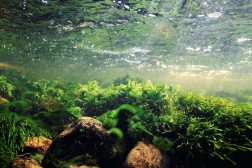
Lotic Communities & Algae
Lotic communities have conditions that are rather harsh for typical plants. Thus, the diversity of plant species in loti..
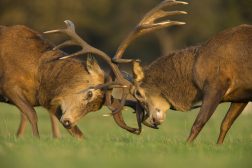
The Gene Pool and Population Genetics
According to Charles Darwin's theory of natural selection, preferable genes are favored by nature in the gene pool, and ..
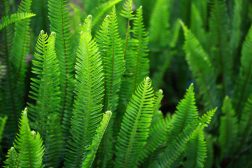
Vascular Plants: Ferns and Relatives
Ferns and their relatives are vascular plants, meaning they have xylem and phloem tissues. Because of the presence of va..
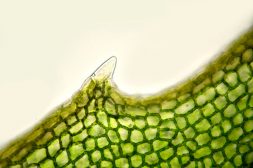
Plant Meristems and Growth
In plants, growth occurs in meristems, which are the site of repeated cell division of unspecialized cells. These cells ..
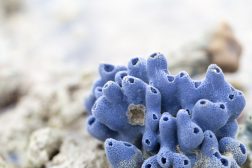
Primitive Animals
Life, as we know it today, is presumed to have started in the sea and many of them were likely eukaryotic animal-like or..
